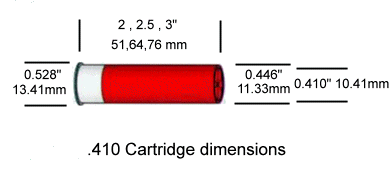| Home |
| This Site |
| Nostalgia |
| Reference |
| Reloading |
| Cartridges |
| Guns |
| Performance |
| Suppliers |
| Shoots |
| Messages |

The mythical 36 gauge
 |
 |
|
The Four-ten is also known as the 36 gauge ( and 12 mm ). We must thank Michael Goines for raising this question of the mythical
36 gauge and the original research that he has performed in trying
to get an answer. |
|
Dear Michael: your question intrigued me and i started researching on it. the task was bigger than i thought... nobody to this date has come up with a very precise answer, even
the president of CIP (the european ruling committee on arms and
ammunition). 1 - all the official documents from european Proof houses before 1904 do not mention .410bore caliber. 2 - In Great Britain, in a 1855 and some previous documents, official
gauges went from 1 (1.669") to 50gauge (.453"). 3 - France, in 1810, try to get away from the british system and
they managed to keep alive two systems: one was similar to the British
(except the french pound was different) and determined gauges fairly
similar in diameter to the british system; 4 - In Germany in the 1800's there is no mention of any gauge smaller than 32 (and by the way they used several different "german" pounds, depending where the gun was manufactured) 5 Austria had a system similar to the english, from 4 to 50 gauge. There was a 36 gauge with diameter 12.4mm (surprise: it is different from the french and english 32...) 6 - Italy was a mess: depending on who was the invader (Austria
or French or Spain) they changed system. 1 - the first official reference to .410 bore caliber is in a 1904 document by the Royal british proof house; the same document has a 36gauge (with the "correct" .506 in diameter). 2 - CIP met for the first time in 1914 and managed to get an agreement
on the nominal diameter of calibers from 12 to 28gauge (12, 14,
16, 20, 24 and 28). There was still some resistance on 4 and 8 gauge
and other bigger calibers (up to 32 mm, which was an italian 1 gauge),
and french and british 8 gauge and 4 gauge stayed until the 40's,
along with the official european 4 and 8 gauge. In the 20's and
30's 14 gauge disappeared and 32 re-appeared. 3 - sometimes in the 20's, someone at CIP (mistery, probably a
swiss or a german..) probably thought of making an ordered and esthetically
pleasant set up...since they had 4, 8, 12, 16, 20, 24, 28 and 32,
why not calling the next smaller (and only remaining) caliber 36
(a precise 4 step). 4 - In the 1961, CIP officialized .410 as the only correct name,
but in 1969 added 36 in parenthesis on the dimensional tables. 5 - The confusion never died, because the french kept calling the
32 gauge 14mm, the .410bore 12mm and they added the .360, calling
it 9mm (later to become a rimfire, with the name of Flobert...awesome
story too). I have to thank you that you gave me an excuse to get away from
the normal day-to-day routine. You can still find some of their books in the out-of-print sections of internet booksellers. My best to you and to all your shooting buddies, Sincerely, Pietro Fiocchi |
A similar theory for "filling in the Gauges .."
| I'm no expert, just a life long "gun nut" who grew up in South America. My theory of the "why the 36" is roughly as follows. The common shotgun gauges in Brazil (where I grew up) were (in descending order) 12, 16, 20, 24, 28, 32, 36, 9mm. CBC (Companhia Brasileira de Cartuchos) manufactured all these in full brass, berdan primed form. I believe that the 36 designation for the "410" was used because it fit in with the other common gauges. At least in Brasil. As for the European use? I've really not much idea, but suspect it is for the same reason. For some reason the 410 gained popularity whereas the other gauges (between 32 and 68) died out with the transition to cartridge arms in the 19th century. This is all conjecture on my part, but it fits the picture I've seen in S. America. Sincerely, Paul W. Moreland |
Also consider Marshall Williams articles on Pre .410 shotguns and .44 gauge shotguns